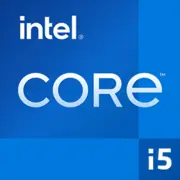Intel Core i5-11600T

Intel Core i5-11600T: Review and Recommendations for PC Building in 2025
(Relevant as of April 2025)
1. Key Specifications: Rocket Lake Architecture and Performance
The Intel Core i5-11600T, released in 2021, remains relevant for budget and energy-efficient systems due to its balanced design.
Architecture and Manufacturing Process
- Codename: Rocket Lake (14 nm). Despite the outdated manufacturing process (newer Intel processors use 7-10 nm), the 14 nm process ensures stability and low heat output.
- Cores and Threads: 6 cores, 12 threads. Base frequency is 1.7 GHz, up to 4.1 GHz in turbo mode.
- Cache: 12 MB L3 — sufficient for most everyday tasks.
- Integrated Graphics: Intel UHD Graphics 750 (basic performance for office applications and light gaming).
Performance
- Geekbench 6: 1454 (single-core), 5699 (multi-core). For comparison, the Ryzen 5 5600G scores around 1600/6200 but is more expensive (about $180 versus $120-130 for the i5-11600T).
- Key Features: Support for PCIe 4.0 (up to 20 lanes), Thunderbolt 4 (via chipset), hardware decoding of AV1 (beneficial for streaming).
2. Compatible Motherboards: LGA 1200 Socket and Chipsets
The i5-11600T uses the LGA 1200 socket, which limits motherboard options to models from the 500 series:
- H510 (from $60): Budget option. No memory overclocking, limited port selection. Suitable for office PCs.
- B560 (from $90): Optimal choice. Supports DDR4-3200, PCIe 4.0 for NVMe, and USB 3.2 Gen 2. Example: ASUS TUF Gaming B560M-Plus.
- H570/Z590 (from $130): Enhanced capabilities (more USB ports, PCIe 4.0 lanes). Z590 supports overclocking, but the i5-11600T has a fixed multiplier.
Tip: For building with the i5-11600T, it’s best to choose B560 for a balance of price and functionality.
3. Supported Memory: DDR4 and Its Potential
The processor only works with DDR4 (up to 3200 MHz). In 2025, DDR5 is already dominant, but DDR4 remains cheaper:
- Recommended Capacity: 16 GB (2x8 GB) for multitasking.
- Examples: Kingston Fury Beast DDR4-3200 (2x8 GB — $45).
- Important: Activate XMP in the BIOS for maximum frequency.
Limitation: No support for DDR5, which reduces upgrade potential.
4. Power Supply: Power Calculation
With a TDP of 35 W, a system with the i5-11600T consumes about 100-150 W (without a discrete graphics card):
- Without a graphics card: A PSU of 300-400 W is sufficient (e.g., be quiet! Pure Power 11 400W — $55).
- With a graphics card (e.g., RTX 3050): A PSU of 500-600 W (EVGA 600 GD — $70).
- Recommendations: Choose power supplies with 80 Plus Bronze certification and overload protection.
5. Pros and Cons of the Processor
Pros:
- Low power consumption (ideal for mini-PCs and quiet systems).
- Good single-threaded performance (suitable for office tasks and light video editing).
- Support for PCIe 4.0 (for fast NVMe drives).
Cons:
- Outdated 14 nm manufacturing process (lacking energy efficiency compared to new AMD Ryzen 7000).
- No support for DDR5.
- Integrated graphics are weaker than those of Ryzen 5 5600G.
6. Use Cases
- Office and Education: Fast work with browsers, documents, Zoom.
- Multimedia: 4K viewing, streaming (hardware AV1 decoding).
- Light Gaming: CS:GO, Dota 2 on low settings (UHD 750 delivers ~40-60 FPS in Full HD).
- Work Tasks: Programming, rendering in Blender (thanks to 12 threads).
Example: A Reddit user built a PC with the i5-11600T for a home theater — the system runs silently and consumes 25 W in idle mode.
7. Comparison with Competitors
- AMD Ryzen 5 5600G ($180): Better graphics (Vega 7), but more expensive.
- Intel Core i5-12400T ($160): Newer architecture (Alder Lake, 10 nm), 15-20% higher performance.
- Ryzen 5 7600 ($220): DDR5, Zen 4, but requires expensive AM5 motherboards.
Conclusion: The i5-11600T wins in price ($120-130) for budget builds.
8. Practical Assembly Tips
- Motherboard: ASRock B560M Pro4 ($95) — good stability and ports.
- Memory: 16 GB DDR4-3200 (G.Skill Ripjaws V — $45).
- Storage: WD Blue SN570 1 TB (PCIe 3.0 — $60).
- Cooling: The stock cooler is sufficient (TDP of 35 W).
- Case: Cooler Master MasterBox Q300L (compact, good ventilation).
Important: Update the BIOS before installing the processor!
9. Final Conclusion: Who Should Choose i5-11600T?
This processor is a good choice if:
- You need a cheap PC for office or school.
- Quiet operation and low power consumption are important (e.g., for a media center).
- You don’t plan to use DDR5 or a high-end graphics card.
Alternatives: If the budget allows, it’s better to opt for the i5-12400T or Ryzen 5 5600G. But for tasks up to $500, the i5-11600T remains a cost-effective option.
Prices are valid as of April 2025. Information is based on data from open sources and user experience.
Basic
CPU Specifications
Memory Specifications
GPU Specifications
Benchmarks
Compared to Other CPU
Share in social media
Or Link To Us
<a href="https://cputronic.com/en/cpu/intel-core-i5-11600t" target="_blank">Intel Core i5-11600T</a>